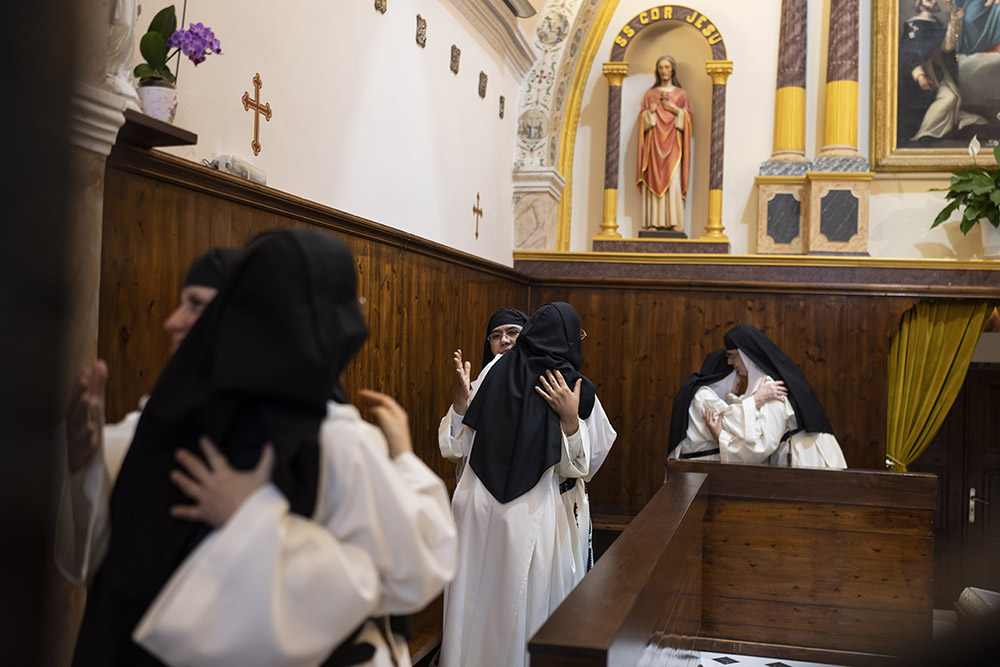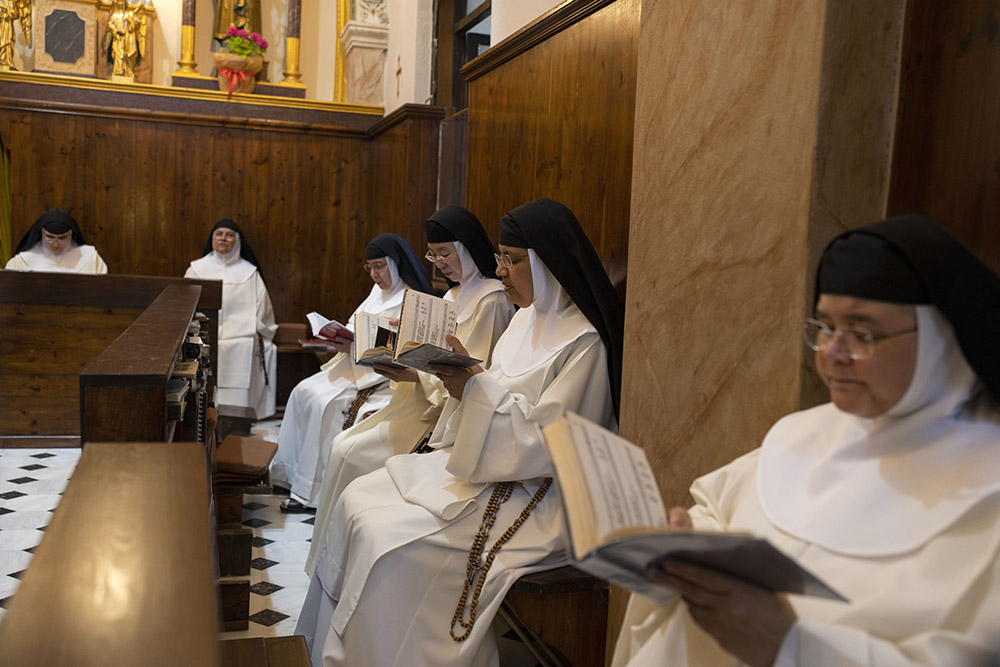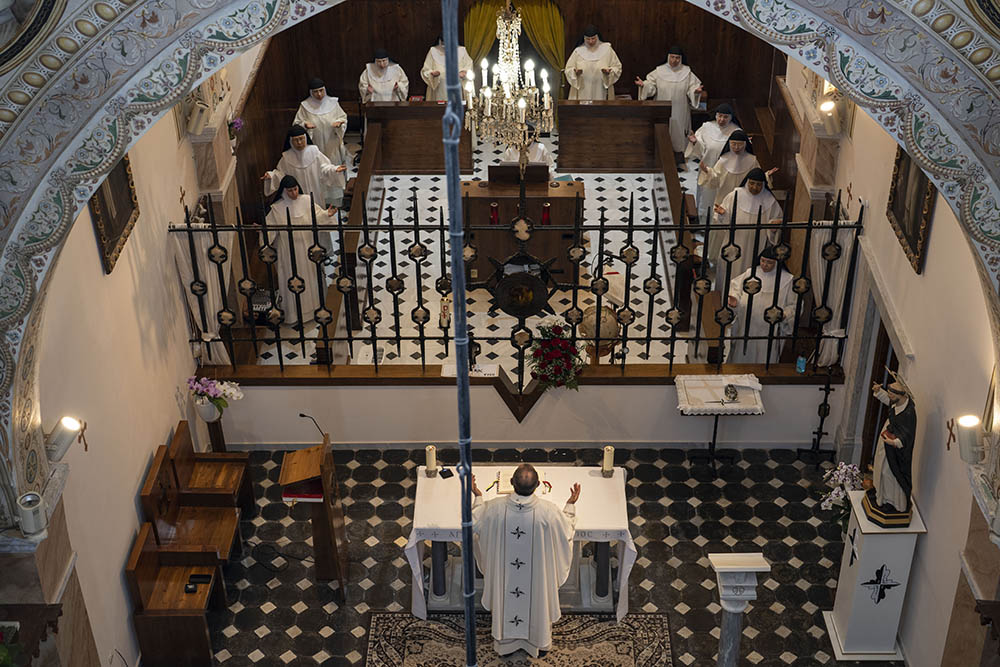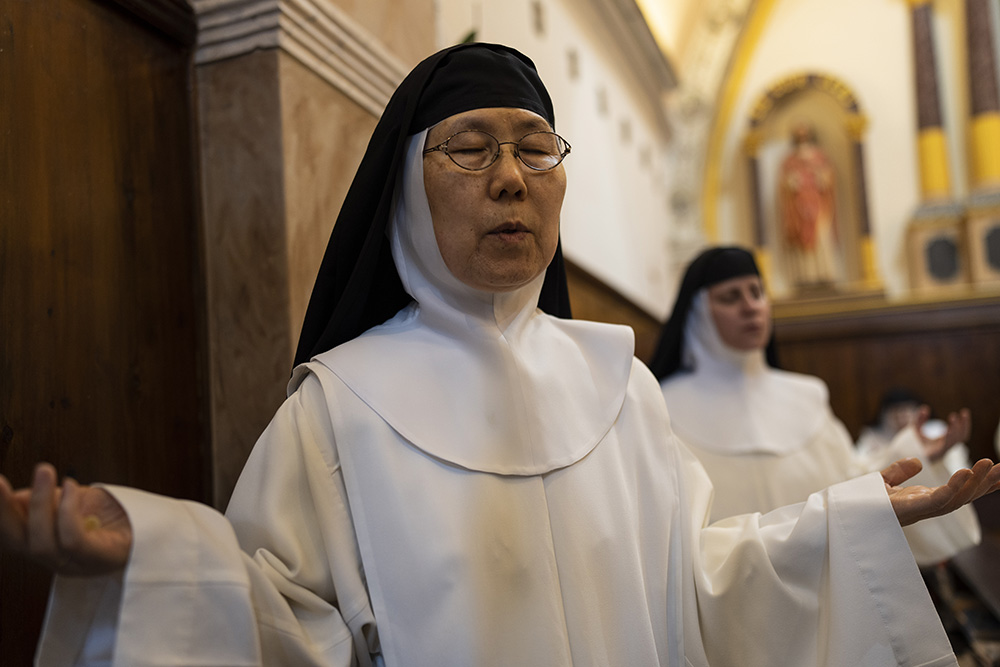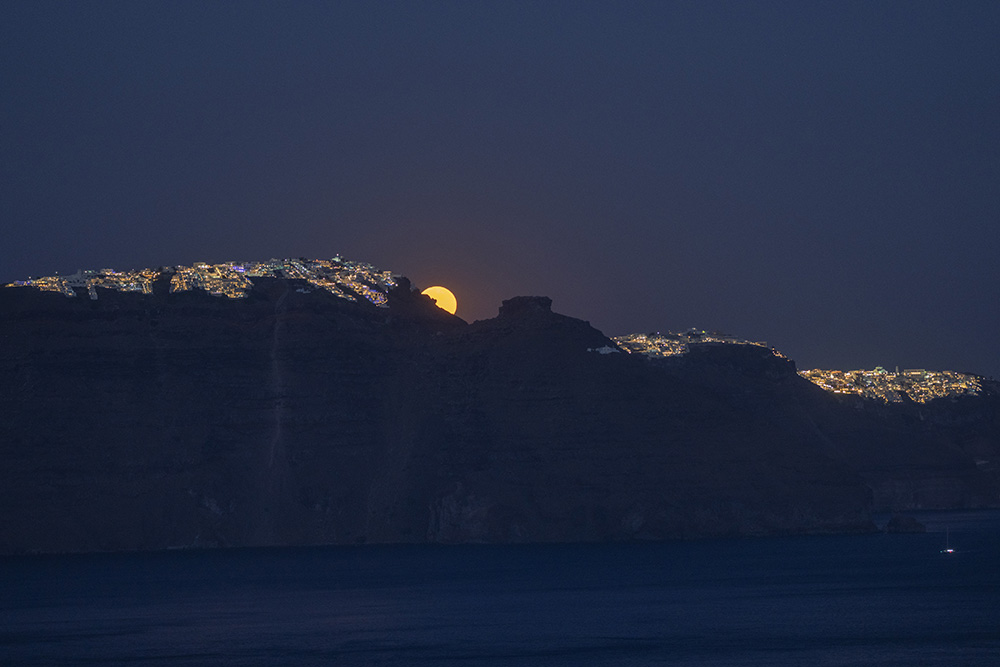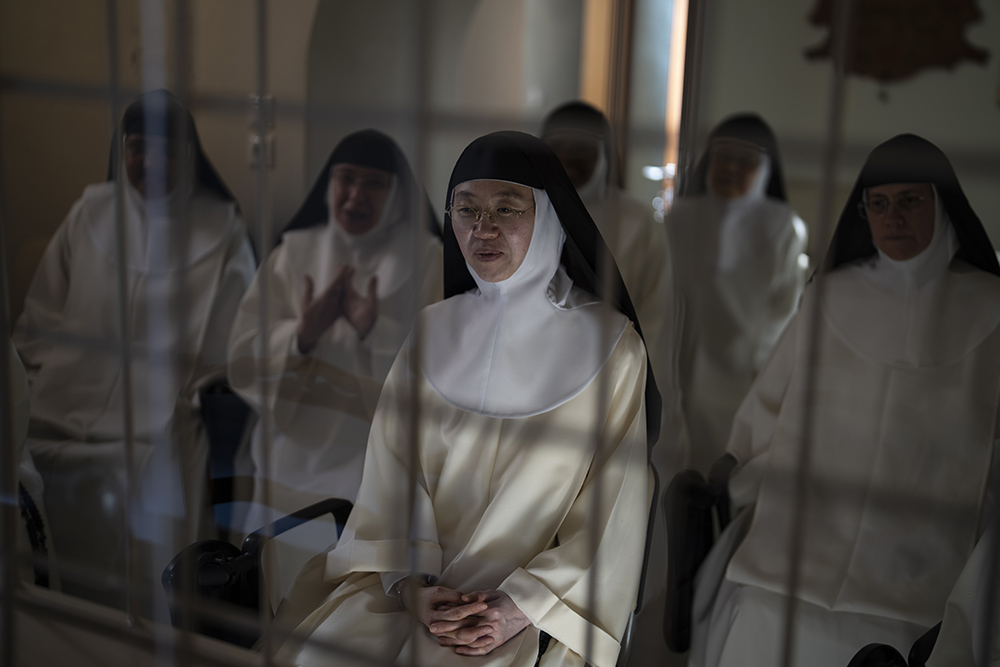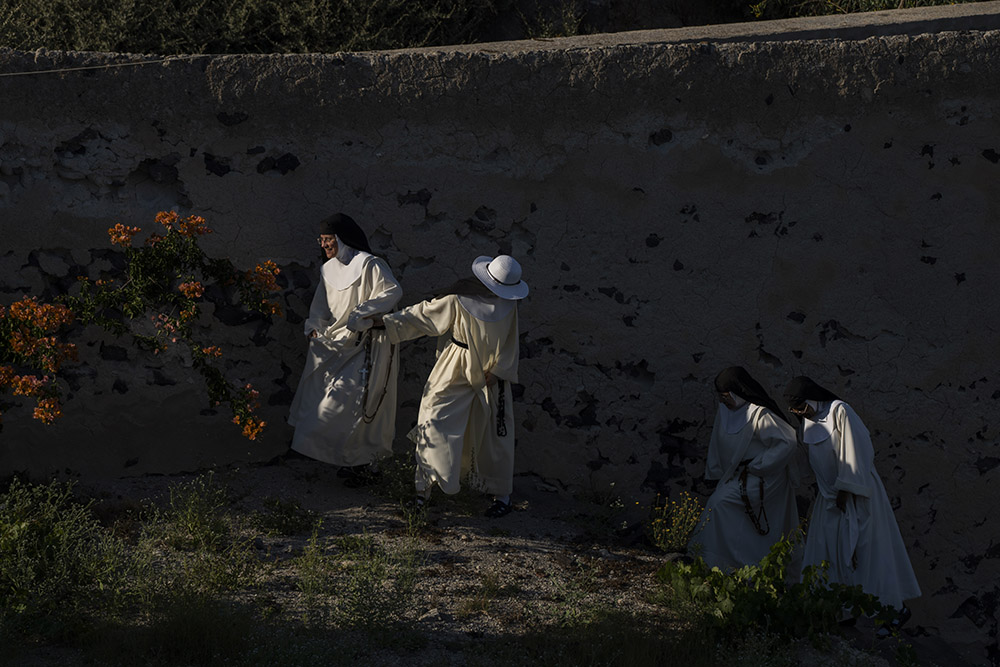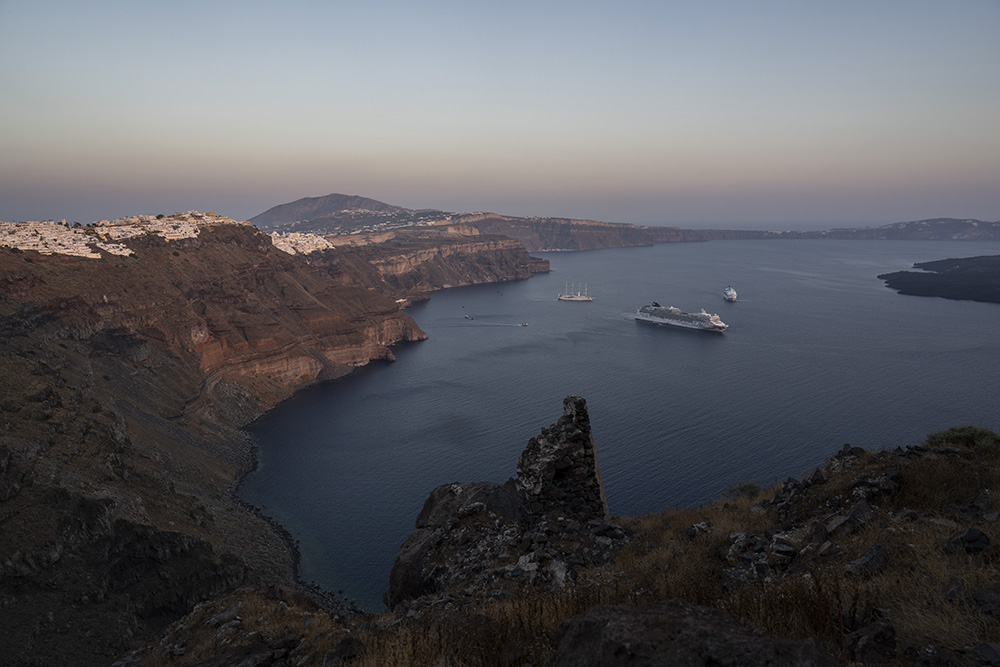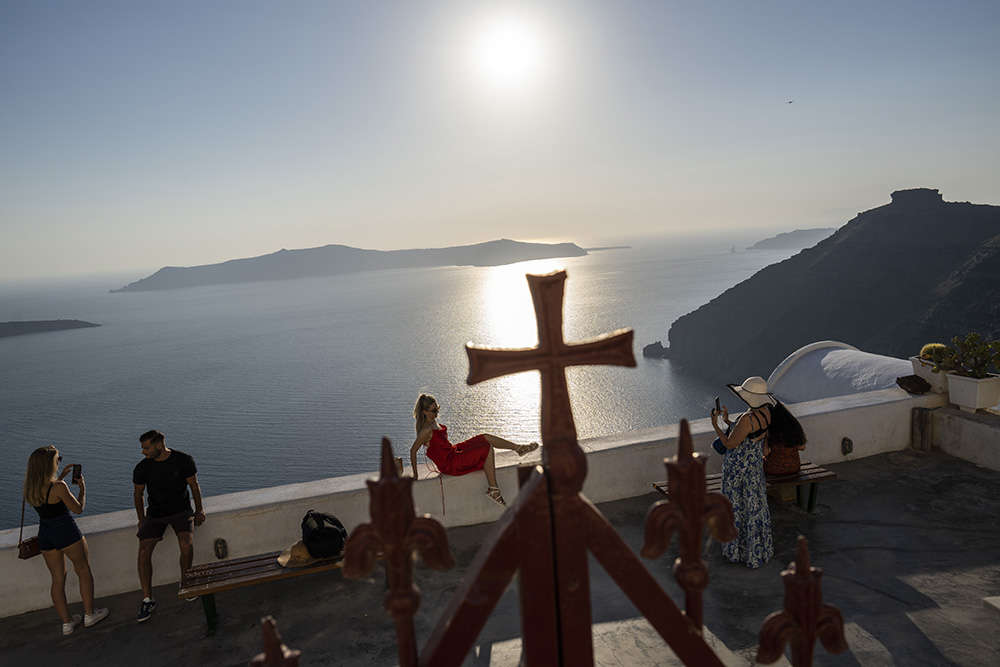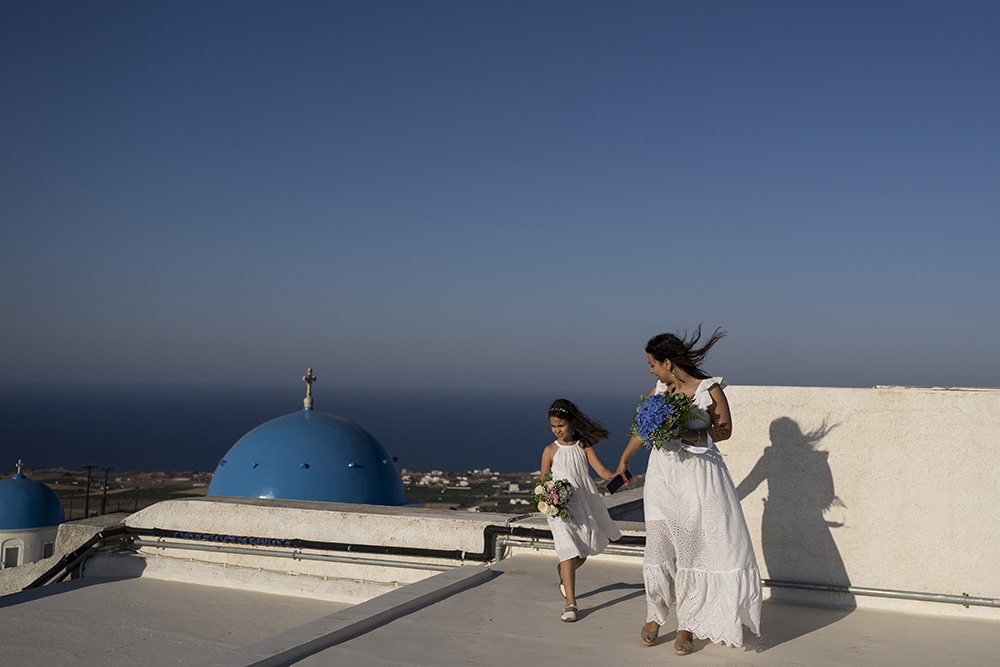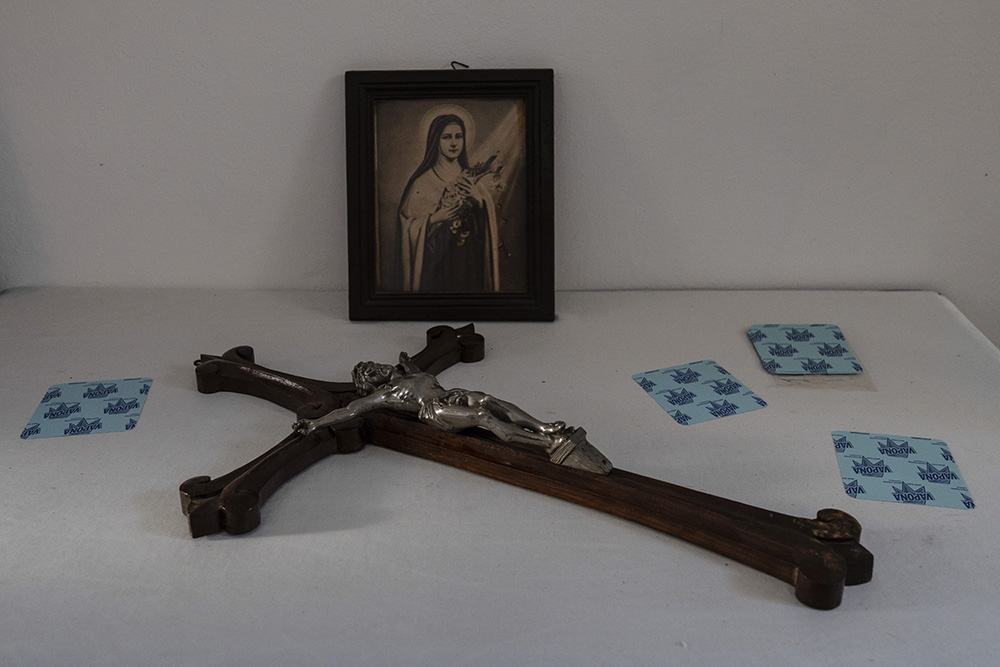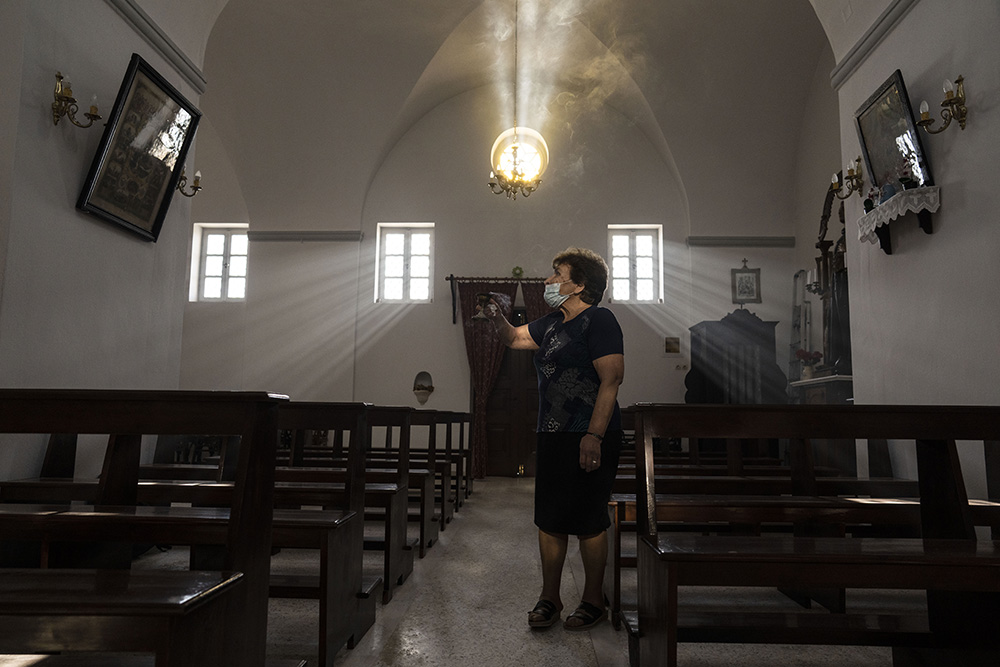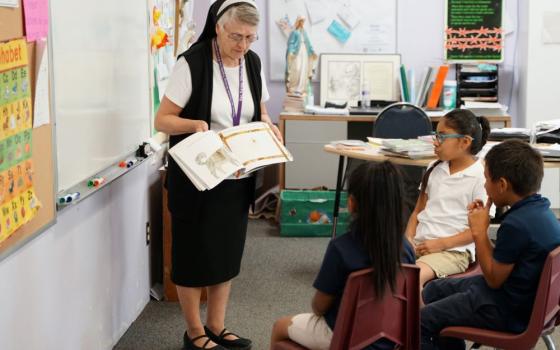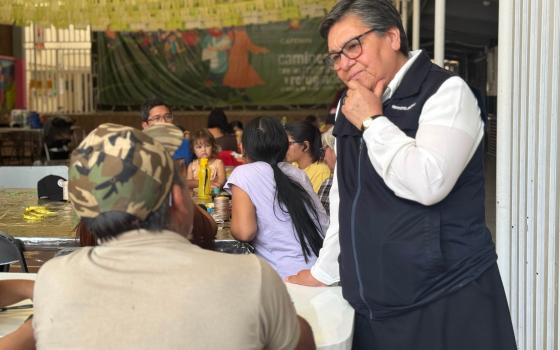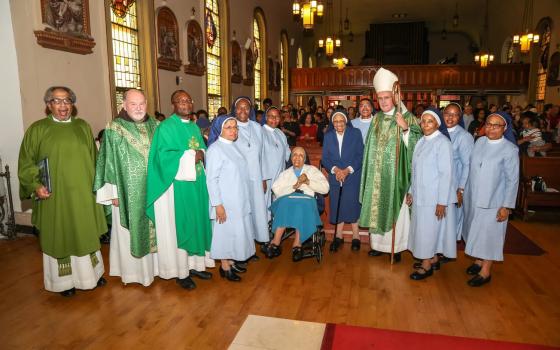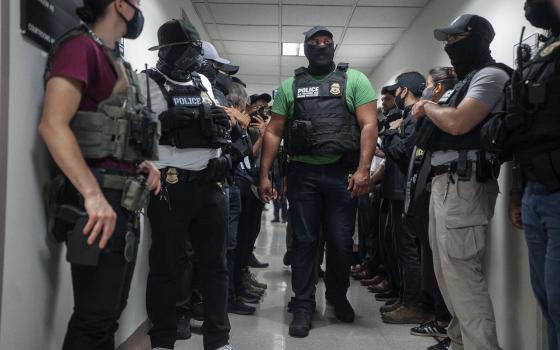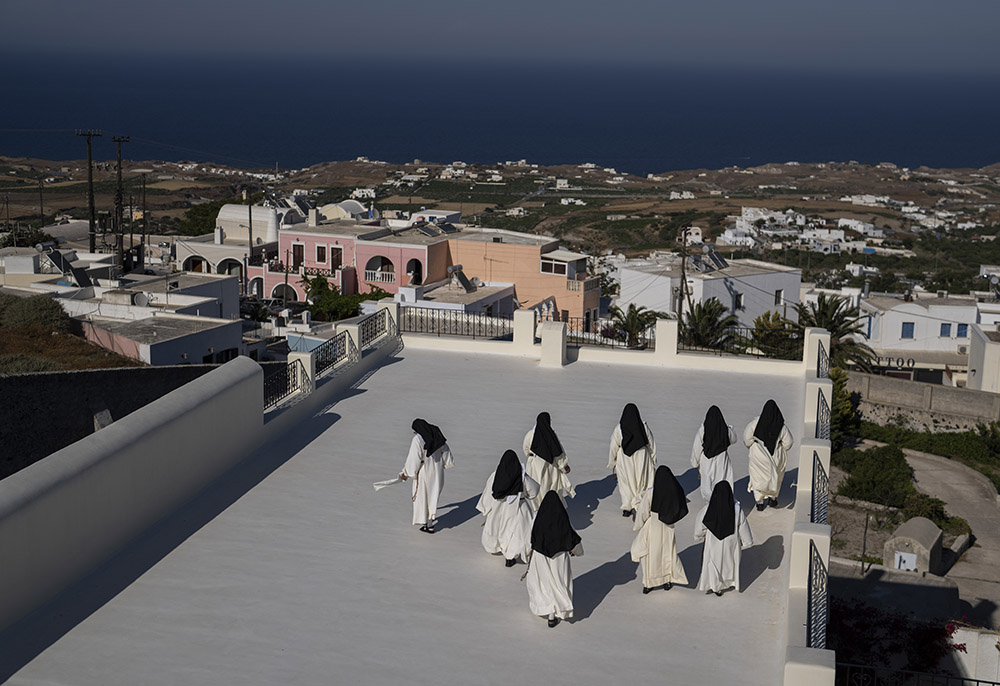
Cloistered nuns walk on a terrace of the Catholic Monastery of St. Catherine on the Greek island of Santorini on June 14. Twice a day, the nuns recess to chat on the convent's wide terraces, the Aegean Sea shimmering in the distance. (AP/Petros Giannakouris)
Cruise-ship tourists crowding souvenir shops and couples chasing the perfect Instagram sunset throng the alleyway outside the Monastery of St. Catherine, steps from Santorini's world-famous volcanic cliffs.
Inside this convent on one of the trendiest islands in Greece, a predominantly Christian Orthodox country, 13 cloistered Catholic nuns devote their lives to praying for those visitors and for the world.
It's a crucial if often misunderstood mission within the church, where constant prayer is deemed necessary to support more outwardly engaged ministries.
"In such a touristy island, the last thing one thinks about is praying — so we are the ones who do it," Sister Lucía María de Fátima, the prioress, said on a recent morning.
She and other sisters spoke in the convent's parlor, from behind a widely spaced white iron grille that demarcates the cloistered space from the outside world. Ending more than two years of pandemic seclusion, the sisters will welcome visitors back to the public part of their church starting at a Mass in early August for the convent's 425th anniversary.
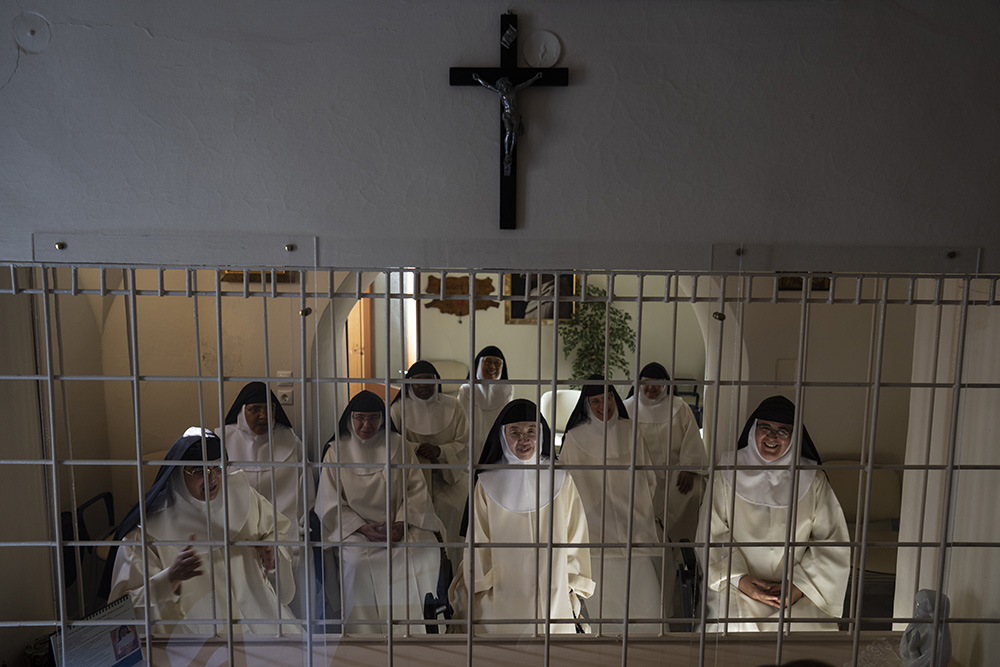
Nuns speak to journalists from behind a white iron grille in the parlor of the Monastery of St. Catherine on the Greek island of Santorini June 14. In the first row, from right to left, are Sister Lucía María de Fátima, the prioress; Sister María de la Trinidad; and Sister María Guadalupe. (AP/Petros Giannakouris)
The rest of the convent is considered a sacred space, where the nuns live mostly in silence and contemplation, leaving only for medical reasons or government requirements.
"After going beyond the grille, we miss nothing. When God gave us the vocation to being cloistered, he gave us the complete package," said Sister María Esclava, who's originally from Puerto Rico.
Fr. Félix del Valle, a Spanish priest, has led periodic spiritual exercises at the convent for more than 10 years, part of the rigorous religious training for the sisters that starts with nine years of preparation before entering the cloistered life.
"In a world of consumption, of diversions, they give witness that God alone is enough," he said.
Many orders of nuns are active in teaching, health care and ministry to vulnerable groups like migrants. But contemplative nuns carry on a tradition of complete devotion to prayer that traces its origins to the first desert hermits, who sought closeness to God by removing all earthly distractions.
Advertisement
"For these women, they find God in a dedicated life of prayer or contemplation," said Margaret McGuinness, professor emerita of religion at La Salle University in Philadelphia.
Sister María de la Iglesia spent nearly 40 years in Santorini before moving to Spain to lead the Federación Madre de Dios, or Mother of God Federation, which oversees the island's convent and nine other Catholic Dominican convents on four continents.
"In today's logic, our life is not understood or valued, but within the church it is," she said. "We're the voice of the church that tirelessly praises, petitions on behalf of our entire humanity. It's a thrilling mission."
When not praying or practicing music and hymns, the sisters — ranging in age from 40s to 80s — do housework; tend to the garden, where they grow tomatoes, lemons and grapes; and make communion wafers for most of the Catholic parishes in Greece.
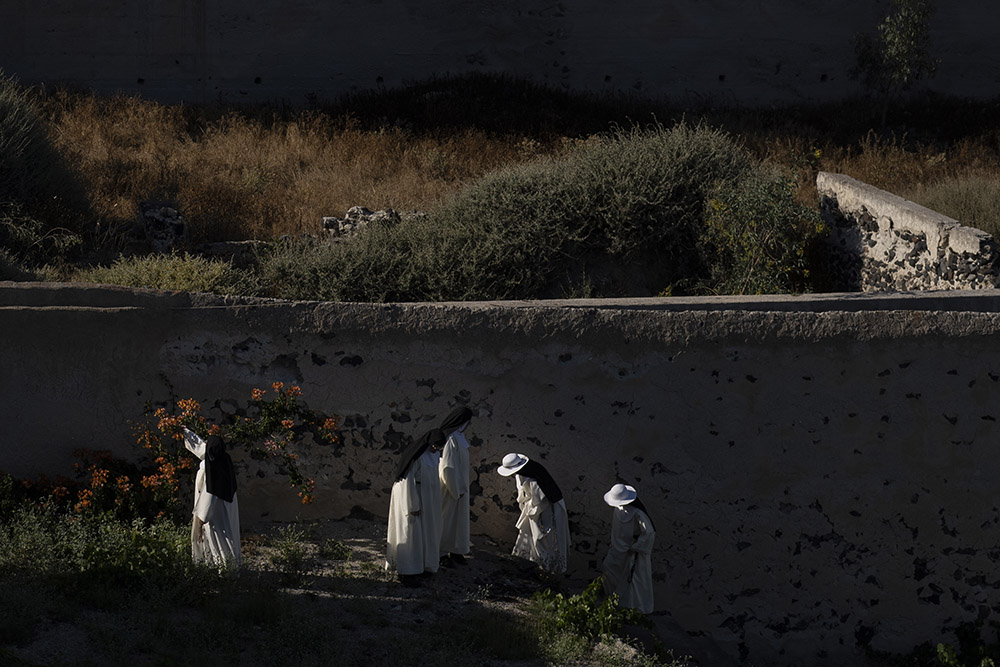
Cloistered nuns walk in the garden of the Catholic Monastery of St. Catherine on the Greek island of Santorini on June 15. When not praying in church or practicing sacred music and hymns, the nuns tend to the garden, where they grow fruits and vegetables. (AP/Petros Giannakouris)
During two daily recesses, they break their silence to chat on the wide terraces, the Aegean Sea shimmering in the distance.
At dawn, a bell calls to the first of about nine hours of prayer, most sung in Latin, Spanish and Greek.
"While the sun rises, creation and the human person join in harmony of praise to God," Sister María Guadalupe said, adding that with monasteries across time zones, someone is always keeping prayer active. "We're not out of the world, but rather very involved in the world."
In majority-Orthodox Greece, the Catholic convent's presence speaks to desired unity with other Christians, the sisters say. They exchange holiday greetings with the island's Orthodox monks and nuns, and recall enthusiastically one visit when they sang hymns together.
"Despite being cloistered, nuns have always been an important element in the life of a place," said Fermín Labarga, professor of church history at the University of Navarra in Spain.
It was in that country that the Dominican order of cloistered nuns was founded more than 800 years ago by St. Dominic, to pray constantly in what Labarga termed the "rear guard" while their fellow religious brought the Gospel to the world.
That "missionary spirit within a contemplative space," in Sister María de la Iglesia's words, continues to animate today's nuns, who wear the historic Dominican black veil and all-enveloping white habit — representing penitence and innocence. They came to Santorini mostly from the Caribbean (Puerto Rico and Santo Domingo), as well as Angola, Korea, Argentina, Greece and Spain.
Sister María de la Iglesia was sent to the island by her order in 1981, when only three nuns were left in the convent.
It was first established in 1596 on the rocky promontory of Skaros — today a popular sunset-watching spot, but then a hideout from pirates. After an earthquake, it was relocated to the main town of Thira a few miles away, where it survived another devastating quake in 1956 that led many residents, including most other Catholic religious, to abandon the island.
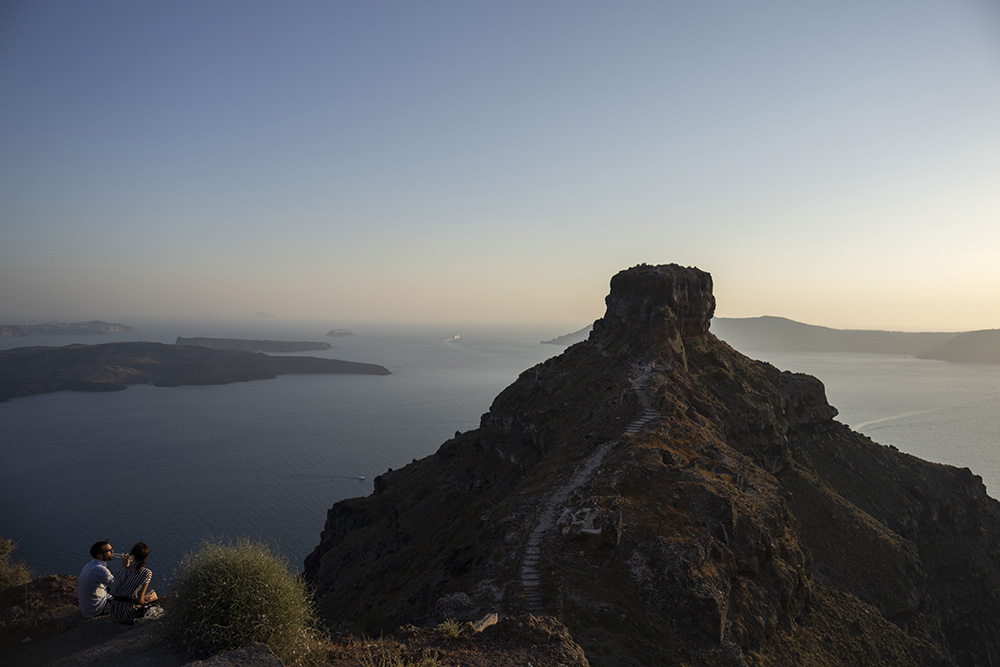
A couple drink wine in front of the rocky promontory of Skaros on the Greek island of Santorini June 15, 2022. The Catholic Monastery of St. Catherine was founded at Skaros in 1596, but after an earthquake it was moved to the nearby village of Thira. (AP/Petros Giannakouris)
Large rocks are embedded in the artistic grille that divides the church's public area from where the sisters pray, near a globe that further symbolizes their connection to their surroundings.
The sisters keep up to date on world events through various Catholic media outlets and newsletters, plus daily Mass homilies. In recent ones, the priest delved into the war in Ukraine, the metaverse and the dangers of parkour.
They also receive prayer petitions from other religious as well as visitors, asking for everything from world peace to healing from disease — "and babies, lots of babies," Sister Maria Flor de la Eucaristía said playfully.
"We suffer too with them, we feel the pain of the families and of the world, but with a certitude of hope that gives us joy," said Sister Maria Fátima, who hails from Angola.
That certainty of belief shines through the sisters' cheerful demeanor despite an austere life that demands sacrifice not only from them but from their families, whom they can only see occasionally behind the grilles.
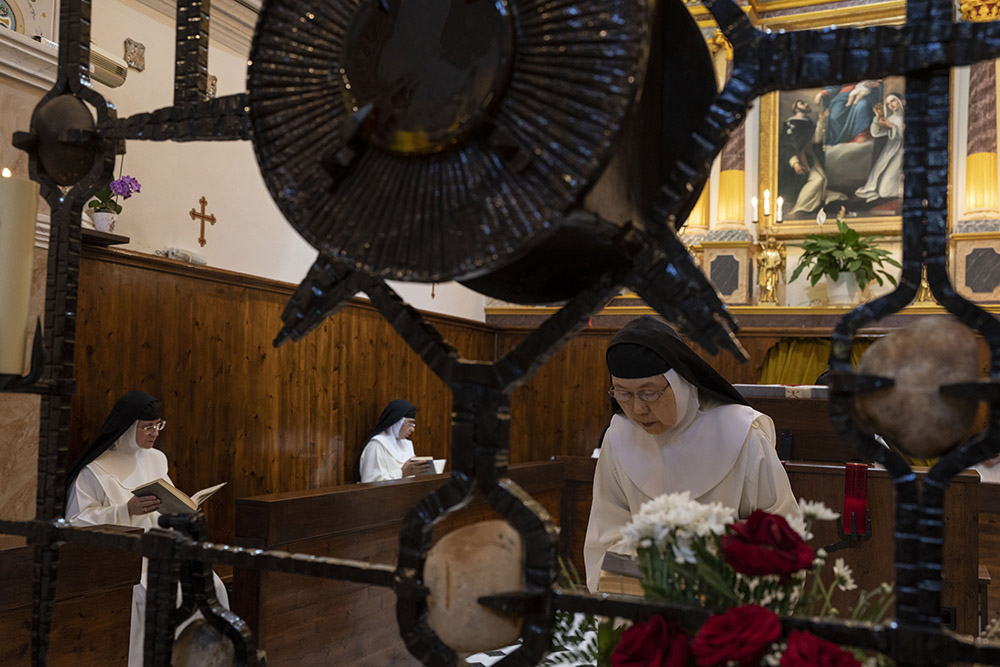
Sister María de Jesús bows her head as Sister María Flor de la Eucaristía, left front, and Sister Amparo de María pray during Mass in the Catholic Monastery of St. Catherine on the Greek island of Santorini June 14. (AP/Petros Giannakouris)
"It's a calling from God. You can't follow any other path. A constant call, so that you can follow it with joy," said Sister Lucía María de Fátima, originally from Argentina.
That joy they find plentifully in their vocation, despite forgoing most activities that draw hundreds of thousands of tourists to Santorini — like going to the beach.
Sister María Isabel said she liked beaches a lot in her native Puerto Rico. Upon entering the Dominican convent there, she could no longer see the ocean.
When she was moved to the main convent in Olmedo, deep in Spain's heartland, she thought she would never see a wave again. Then came the mission in Santorini.
"God gives you grace that you had not expected," she said, smiling broadly, before the bell tolled, and she rushed off to church, to keep singing God's praise.
[Associated Press religion coverage receives support through the AP's collaboration with The Conversation US, with funding from Lilly Endowment Inc. The AP is solely responsible for this content.]
